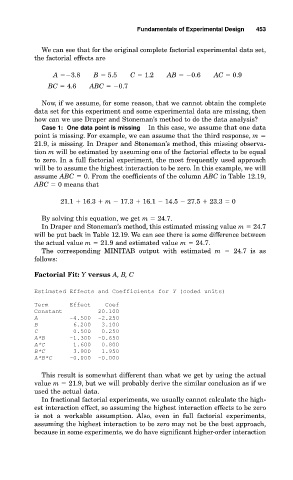Page 494 - Design for Six Sigma a Roadmap for Product Development
P. 494
Fundamentals of Experimental Design 453
We can see that for the original complete factorial experimental data set,
the factorial effects are
A 3.8 B 5.5 C 1.2 AB 0.6 AC 0.9
BC 4.6 ABC 0.7
Now, if we assume, for some reason, that we cannot obtain the complete
data set for this experiment and some experimental data are missing, then
how can we use Draper and Stoneman’s method to do the data analysis?
Case 1: One data point is missing In this case, we assume that one data
point is missing. For example, we can assume that the third response, m
21.9, is missing. In Draper and Stoneman’s method, this missing observa-
tion m will be estimated by assuming one of the factorial effects to be equal
to zero. In a full factorial experiment, the most frequently used approach
will be to assume the highest interaction to be zero. In this example, we will
assume ABC 0. From the coefficients of the column ABC in Table 12.19,
ABC 0 means that
21.1 16.3 m 17.3 16.1 14.5 27.5 23.3 0
By solving this equation, we get m 24.7.
In Draper and Stoneman’s method, this estimated missing value m 24.7
will be put back in Table 12.19. We can see there is some difference between
the actual value m 21.9 and estimated value m 24.7.
The corresponding MINITAB output with estimated m 24.7 is as
follows:
Factorial Fit: Y versus A, B, C
Estimated Effects and Coefficients for Y (coded units)
Term Effect Coef
Constant 20.100
A -4.500 -2.250
B 6.200 3.100
C 0.500 0.250
A*B -1.300 -0.650
A*C 1.600 0.800
B*C 3.900 1.950
A*B*C -0.000 -0.000
This result is somewhat different than what we get by using the actual
value m 21.9, but we will probably derive the similar conclusion as if we
used the actual data.
In fractional factorial experiments, we usually cannot calculate the high-
est interaction effect, so assuming the highest interaction effects to be zero
is not a workable assumption. Also, even in full factorial experiments,
assuming the highest interaction to be zero may not be the best approach,
because in some experiments, we do have significant higher-order interaction

